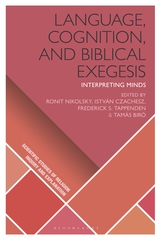|
|
Recent publications
2024
Ki met√©lte k√∂r√ľl √Ābrah√°mot?: Biblia√©rtelmez√©s a kognit√≠v vall√°studom√°ny szempontj√°b√≥l.
[Who Circumcised Abraham? Biblical Exegesis and the Cognitive Science of Religion]
Magyar Tudom√°ny, 185 (2004), pp. 444–453. DOI: 10.1556/2065.185.2024.4.2. Direct
link, or
pdf.
2023
Yehezkel Kaufmann és a zsidó bibliakritika.
M√ļlt √©s J√∂vŇĎ 2023/4, pp. 111–120.
(See also M√ļlt √©s J√∂vŇĎ.)
PeregrXML √©s egy k√∂z√©pkori kereszt√©ny h√©ber korpusz: A k√∂sz√∂ntŇĎversek a digit√°lis b√∂lcs√©szet szemsz√∂g√©bŇĎl.
Koltai, Korn√©lia and Zsengell√©r, J√≥zsef (eds.), ◊©◊ô◊® ◊§◊©◊ē◊ė ◊ē◊ě◊ó◊ē◊ú◊ß: H√©ber √ľdv√∂zlŇĎversek √©s a peregrin√°ci√≥,
Budapest: Magyar Hebraisztikai T√°rsas√°g, L’Harmattan Kiad√≥, 2023, pp. 131–151.
(Order here, or download
here.)
Download article.
Két kommentár Gen 17-hez.
Kereszt√©ny–Zsid√≥ Teol√≥giai √Čvk√∂nyv 24 (2023), pp. 7–13.
Download.
2022
A Rabbik√©pzŇĎ ‚Äěnyelvi t√°jk√©pe‚ÄĚ: ElŇĎzm√©nyek √©s az elsŇĎ √©vtized.
Balogn√© T√≥th Katalin (szerk.), „K√∂lesdrŇĎl indultam...”: Sz√ľlet√©snapi eml√©kk√∂tet Prof. Dr. Ol√°h J√°nos z"l tisztelet√©re,
Gabbiano Print: Budapest, 2022, pp. 77–118.
Download.
Who Circumcised Abraham? A Cognitive Network Model for the Interpretations of Gen 17.
Annali di Storia dell’ Esegesi 39.1, pp. 121–143.
Download.
2021
Jewish Hungarian.
Sarah Bunin Benor (ed.), Jewish Language Website. Los Angeles: Jewish Language Project.
Link or
pdf.
The Jewish Mind: A cognitive science of religion approach to and in Judaism.
Vizi, E. Szilveszter and Sára Réka Kabai and Gabriella Kenéz and Flóra Moravcsik-Nagy and Alexandra Hortenzia Nagy (eds.),
Hit, tudom√°ny √©s t√°rsadalom = Faith, Science and Community, Szent Istv√°n T√°rsulat: Budapest, 2021, pp. 279–288.
Download.
2019
OT grammars don’t count, but make errors: The consequences of strict domination for simulated annealing.
B. Gyuris, K. Mády, G. Recski: K + K = 120: Papers dedicated to László Kálmán and András Kornai on the occasion of
their 60th birthdays. Revised and extended edition. MTA Research Institute for Linguistics, Budapest, 2019.
Link.
Liturgical Linguistics: Towards the Syntax of Communicating with the Super-Human Agent in Judaism.
In Nikolsky et al., Language, Cognition, and Biblical Exegesis: Interpreting Minds, Bloomsbury, 2019, pp. 128‚Äď148.
Ronit Nikolsky, István Czachesz, Frederick S. Tappenden, Tamás Biró (eds.),
Language, Cognition, and Biblical Exegesis: Interpreting Minds,
Bloomsbury: London, Oxford, etc., 2019. ISBN: 9781350078123. 256 pp.
Publisher’s site.

2018
A bibliai h√©ber hat√°roz√≥i accusativus √©s az -a directivus: N√©h√°ny gondolat nyelvt√∂rt√©neti hipot√©zisekrŇĎl √©s narrat√≠v√°kr√≥l.
In D√°vid N√≥ra, Fodor Gy√∂rgy √©s Ňźze S√°ndor (szerk.), T√≠z √©vh√©t: Tanulm√°nyok Fr√∂hlich Ida 70. sz√ľlet√©snapja alkalm√°b√≥l,
Szent Istv√°n T√°rsulat: Budapest, 2018, pp. 19–33.
Download. A neológ és a református szakrális tér átalakulása a 19. században:
Egy strukturális-összehasonlító vallástörténeti ujjgyakorlat.
In: Oláh János és Zima András (eds.), Schöner Alfréd hetven éves
/ Essays in Honor of Alfred Schöner.
Gabbiano Print Nyomda √©s Kiad√≥: Budapest, 2018, pp. 67–83.
Download preprint (penultimate proof) or
published version (scanned).
2017
OT grammars don’t count, but make errors: The consequences of strict domination for simulated annealing.
Be√°ta Gyuris, Katalin M√°dy, and G√°bor Recski (eds.),
K + K = 120. Papers dedicated to László Kálmán and András Kornai on the occasion of their 60th birthdays.
MTA Nyelvtudományi Intézet (Research Institute for Linguistics, Hungarian Academy of Sciences), 2017.
ISBN 978-963-9074-73-6. URL: http://www.nytud.hu/kk120.
Download paper.
Workshop slides.
Bir√≥ Tam√°s, Optimalit√°selm√©let √©s gyorsbesz√©d: Egy nyelvtanmodelltŇĎl a besz√©d modellez√©s√©ig, sŇĎt a k√≠s√©rletekig.
[Optimality Theory and fast speech: From a grammar model to modelling speech to experiments.]
√Āltal√°nos Nyelv√©szeti Tanulm√°nyok XXIX. K√≠s√©rletes nyelv√©szet. (Kenesei Istv√°n, fŇĎszerk., B√°nr√©ti Zolt√°n, szerk.)
Akad√©miai Kiad√≥: Budapest, 2017, pp. 127–153.
(Publisher’s site.)
Tamás Biró, Uncovering structure hand in hand: Joint Robust Interpretive Parsing in Optimality Theory.
Acta Linguistica Academica 64.2 (2017): 191–212. DOI: 10.1556/2062.2017.64.2.2.
Publisher.
Download.
2016
Tamas Biro, (Not) only the circumcised may circumcise: theological correctness and and intuitive religiosity in Judaism
(abstract).
In: Bochinger, Christoph and R√ľpke, J√∂rg (eds.), Dynamics of Religion: Past and Present (De Gruyter: 2016, pp. 311–505),
p. 419.
Link
(and local link).
Biró Tamás, Egy befejezetlen beszélgetés tanulságai.
In: Peremiczky Szilvia, et al. (eds.): Schweitzer J√≥zsef eml√©kezete: A hal√°l√°nak elsŇĎ √©vfordul√≥j√°n rendezett tudom√°nyos konferencia
k√∂sz√∂ntŇĎbesz√©dei √©s elŇĎad√°sai (MAZSIHISZ: Budapest, 2016, pp. 128‚Äď157).
Download.
Biró Tamás, Az áldozat fogalma kognitív vallástudományi megközelítésben.
In: Hubai P√©ter (ed.): √Āldozat: ElŇĎad√°sok a vall√°studom√°ny √©s a theol√≥gia vonz√°sk√∂r√©bŇĎl, Wesley J√°nos Lelk√©szk√©pzŇĎ FŇĎiskola, 2015. m√°jus 1-3.
(Wesley J√°nos Lelk√©szk√©pzŇĎ FŇĎiskola: Budapest, 2016, pp 38‚Äď53).
Download.
Older publications
MTMT database
|